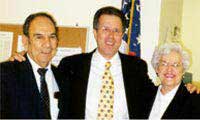How can you get a temporary visa to visit, study or work in the United States?

Temporary work visas include E, H, J, L, O, P, R and TN visas. The most common ways to visit the US are B-1 and B-2 visas and the Visa Waiver Program. Persons may study in the US using F-1, M-1 and J-1 temporary visas.
This page contains a number of articles and links explaining the various types of temporary visas. It explains the difference between a “visa” and a “status”. We explain the procedure for obtaining a visa abroad as well as the process of applying for an extension of stay or a change of status in the U.S. We link to the online visa appointment system for U.S. Consulates in Canada and Mexico. We explain the most common temporary or “non-immigrant” visa categories, in alphabetical order from “A” to “U”.
Our attorneys have obtained temporary visas for thousands of E-2 treaty investors, H-1B professionals, J-1 trainees, L-1 intracompany managers and executives, O-1 persons of extraordinary ability, P-1 athletes and entertainers, R-1 religious workers and persons in TN occupations. We represent hundreds of employers and thousands of computer professionals, physicians, accountants, engineers, scientists, health care professionals including registered nurses across the US.
You can stay up-to-date with the latest immigration laws and procedures by subscribing to our Free E-Mail Newsletter.
Client Reviews

Great Work!
“We are very pleased by the services we get from the Law Offices of Carl Shusterman. Our experience in the past year with all our H1B renewals has been amazing, and we’ve obtained great results.”
- KRG Technologies, Valencia, California
Read More Reviews
Zoom Consultations Available!
Temporary Visas is divided into the following subtopics:
- Categories of Temporary Visas
- General Information
- Success Stories
- Applying for a Temporary Visa in Canada or Mexico
- Humanitarian Parole
- Practice Advisories
CATEGORIES OF TEMPORARY VISAS
- Diplomats and Foreign Government Officials (“A”)
- Visitor Visas to the U.S. (“B-1/B-2”)
- Visa Waiver Program – ESTA (State Department)
- Transit Visas (“C”)
- Crewmen (“D-1”)
- Treaty Traders (“E-1”)
- Treaty Investors (“E-2”)
- Australian Professionals (“E-3”)
- Students (“F-1”)
- Employees of International Agencies and NATO (“G” and “NATO”) (State Department)
- Professional Workers (“H-1B”)
- Agricultural Workers (“H-2A”) (USCIS)
- Skilled and Unskilled Workers (“H-2B”)
- Trainees (“H-3”)
- Foreign Journalists (“I”) (USCIS)
- Exchange Visitors (“J-1”) and Waivers
- Fiances of U.S. Citizens (“K-1”)
- Spouses of US Citizens (“K-3”)
- Intracompany Transferees (“L-1”)
- Persons of Extraordinary Ability (“O”)
- Athletes and Entertainers (“P”)
- International Cultural Exchange Visitors (“Q”)
- Religious Workers (“R”)
- Witnesses and Informants (“S”) (Justice Department)
- Victims of Trafficking (“T”) (USCIS)
- Canadian and Mexican Professionals Under NAFTA (“TN”)
- Visas for Crime Victims (“U”)
GENERAL INFORMATION – TEMPORARY VISAS
- What is a US Visa? (State Department)
- U.S. Visas News (State Department)
- Global Visa Wait Times (State Department)
- Visas – Frequently Asked Questions (State Department)
- Fees for Visa Services (State Department)
- A-Z Index (State Department)
- Attending a Non-Immigrant Visa Interview at a US Embassy (State Department)

- A New Way to Apply For Your Visa: The DS-160 (State Department)

- Applying for Admission into the United States (CBP)
- Enforcement at the Airport – Know Your Rights (ACLU)
- Automatic Visa Revalidation
- Nonimmigrants – USCIS Policy Manual
- How Do I Get An Extension of Stay in the U.S.? (USCIS)
- Who May Apply to Change to a New Nonimmigrant Status (USCIS)
- Policy Memo Regarding Extensions of Status for Cohabitating Partners of Nonimmigrants
- Nonimmigrant Waivers
- “Dual Intent” Doctrine
- Visa Denials (State Department)
SUCCESS STORIES – TEMPORARY VISAS

- Overcoming a Prior Deportation Order
- Obtaining a U Visa for a Crime Victim
- From Humanitarian Parolee to Permanent Resident
- O-1 Visa for an Architect of Extraordinary Ability
- Obtaining an E-2 Treaty Investor’s Visa
- Finding Another Way to Work in the U.S. Following an L-1 Denial
- Is It Unauthorized Employment to Run a Business?
- Proving Specialized Knowledge for an L-1B
- Getting an H-1B Approved for a Remote Worker
- Avoiding the H-1B Cap with a Little Help from the USCIS
- H-3 Trainee Visas and Special Education
- Winning an Appeal Before the AAO
APPLYING FOR A TEMPORARY VISA IN CANADA OR MEXICO
HUMANITARIAN PAROLE
PRACTICE ADVISORIES REGARDING VISAS
- Litigation for Business Immigration Practitioners (6-10-21)
- USCIS Visa Petition Denials on the Rise (8-16-19)
- The H-4 Visa Classification (3-26-18)
- Trump Administration to Announce H-1B Visa Changes (4-17-17)
- Challenges for Visa Waiver Program Overstays (3-20-17)
- Employment-Based Visa Categories in the United States (9-17-16)
- The Exchange Visitor Program and J-1 Visas (5-26-16)








